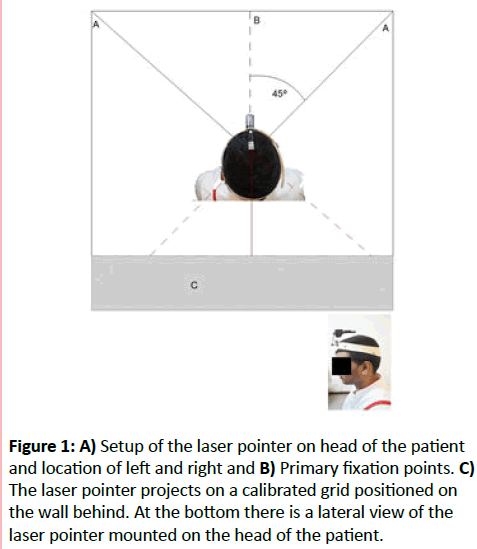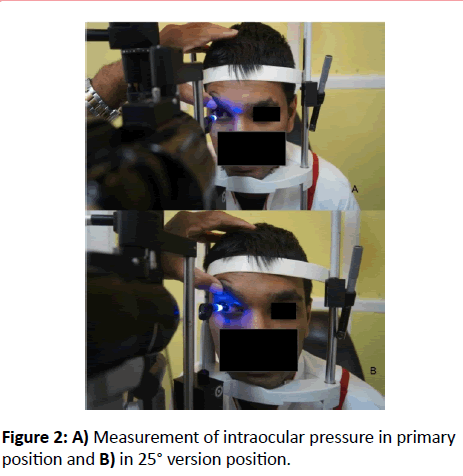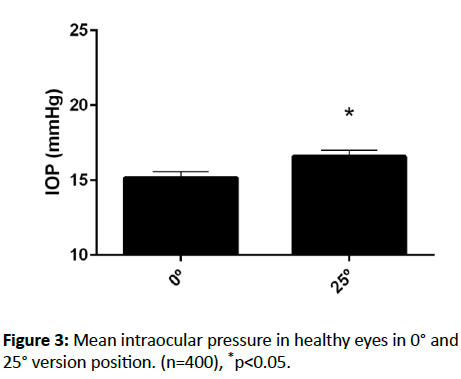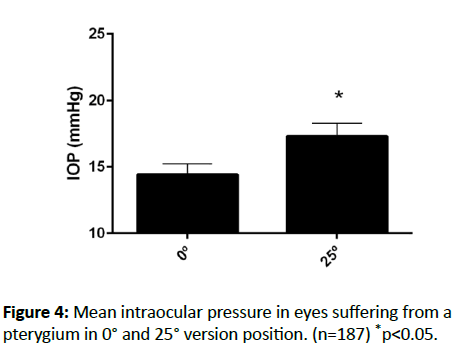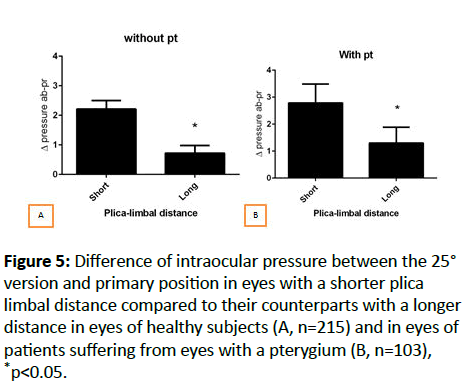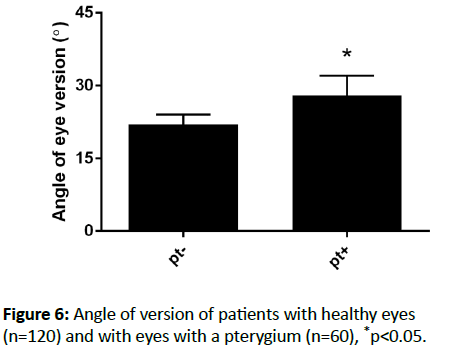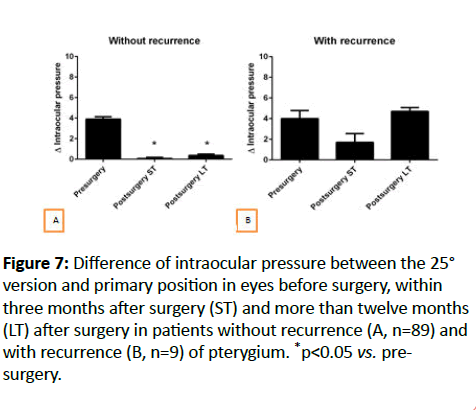Themen HCI1,2*, Mans DRA3, Forster C1, Pawiroredjo JC1, Siban M1, de Mesquita ATB1,2 and Bipat R4
1Department of Ophthalmology, Suriname Eye Center, Academic Hospital Paramaribo, Paramaribo, Suriname, USA
2Department of Ophthalmology, Faculty of Medical Sciences, Anton de Kom University of Suriname, USA
3Department of Pharmacology, Faculty of Medical Sciences, Anton de Kom University of Suriname, USA
4Department of Physiology, Faculty of Medical Sciences, Anton de Kom University of Suriname, USA
- *Corresponding Author:
- Themen HCI
Department of Ophthalmology, Suriname Eye Center
Academic Hospital Paramaribo, Flustraat 1, Paramaribo, Suriname, USA
Tel: 597 442222 # 585
Fax: 597 441071
E-mail: hthemen68@gmail.com
Received date: August 26, 2016; Accepted date: October 19, 2016; Published date: October 25, 2016
Citation: Themen HCI (2016) Excessive Traction on Conjunctiva during Eye Version may Contribute to the Development of Nasal Pterygium. J Eye Cataract Surg 2:14. doi: 10.21767/2471-8300.100014
Copyright: © 2016 Themen HCI, et al. This is an open-access article distributed under the terms of the Creative Commons Attribution License, which permits unrestricted use, distribution, and reproduction in any medium, provided the original author and source are credited.
Keywords
Nasal pterygium; Limbal conjunctiva; Ocular version
Introduction
Pterygium is a wing-shaped fibro-vascular overgrowth of the conjunctiva that originates from the limbal epithelial stem cells [1]. Ultraviolet radiation, dust, and chronic irritation of the conjunctiva are among the most common factors that may contribute to the development of ocular pterygium [2]. More recent theories also suggest the involvement of excessive angiogenesis or a viral infection in the pathogenesis of this disorder, although the precise mechanism(s) of these factors has yet to be determined [3-5].
In a previous study we found a linear relationship between a short plica-limbal distance and the occurrence of pterygia, suggesting that mechanical tension could also be of importance in the development of this disorder [6]. A recent analysis of patient data between 1989 and 2013 revealed that the recurrence rate of pterygia is significantly lower after treatment with conjunctival limbal autograft or amniotic membrane graft, procedures that lower mechanical traction in abduction on the nasal limbal conjunctiva and cornea [7-10]. In addition to these, the longitudinal proliferation of connective tissue in pterygia as well as the observation that removal of both the normal and the affected subconjunctival tissue lowers the recurrence of the disorder, may also support the view that a conjunctival mechanical tension is present prior to the development of the lesion [11].
Studies evaluating the relationship between factors that increase conjunctival tension on one hand and the development of pterygium on the other hand are scant since the measurement of the forces of traction in a delicate tissue like the conjunctiva is extremely difficult and needs quite an aggressive intervention on the patient’s eye. However, a relatively simple and non-invasive method to assess the amount of traction on the bulbar surface is the monitoring of the increase in intraocular pressure with eye movement. A study in a single patient demonstrated that the IOP increased significantly with lateral eye movements [12]. In addition, investigators found a significant variation of intraocular pressure (IOP) in children suffering from cerebral palsy and they registered significant increases in intraocular pressure in the eyes of the patients with lateral spastic presentations [13]. Finally, researchers showed that intraocular pressure rose with maximum right or left gaze [14]. These findings support the possibility to assess the amount of conjunctival traction on the ocular bulbus by monitoring the intraocular pressure in the context of pterygial traction.
In the present study we provide additional evidence to prove that mechanical traction during eye version on the conjunctiva can also be on the basis of the development of this ocular disorder. For this purpose we measured the variation of intraocular pressure in healthy subjects and subjects presenting with a primary nasal pterygium and determined the correlation of the intraocular pressure with movements of eye and head. In addition we assessed the degree of movement of the eye in lateral version in relation to the development of pterygia.
Patients and Methods
Selection of patients
Subjects were selected from patients reporting for routine eye examination at the walk-in clinic of the department of ophthalmology of the academic hospital paramaribo. Only patients living and working in the coastal area were selected, since the UV-index in this region is fairly constant and evenly distributed [15]. Individuals suffering from visual impairment of less than 3/10 in either eye, motility disorders of the eye, with conjunctival scars caused by other factors than primary pterygium, or receiving treatment for glaucoma were excluded from this study. All patients with a unilateral or bilateral pterygium and without other ocular or metabolic disorders affecting the eyes were included in the study. Subjects who came for surgical treatment of symptomatic primary pterygium were included in the pterygium group and allocated to the post-surgery group after having been operated on their eye. All selected persons or their legal guardians had given oral and written consent for participating in the study, and the study design had been approved by the Board of Ethics of the Faculty of Medical Science of the Anton de Kom University of Suriname and the managing directors of the Academic Hospital Paramaribo.
Measurement of plica-limbal distance
The distance between the temporal bulbar semilunar plica and the limbus was measured as described previously [6]. Briefly, the slit of a Haag-Streit slitlamp (model 900, 1998, Bern, Switzerland) projected perpendicular on the bulbar conjunctiva or cornea. With the minimum and maximum length of the slit the plica-limbal distance was determined in maximum or full abduction in the longest measurable proportion during routine motion of the eye. In most patients it was possible to measure this distance accurately. However, especially in young people without pterygium, extraordinary long plica –limbal distances could not be measured because the plica was not visible in full abduction. In this case it was concealed by the partially unfolded fornix conjunctivae, even though maximum ocular version is more pronounced at young age [16]. These were excluded from further participation in the study.
Registration of head and ocular movement
Subjects were asked to sit on a chair facing the primary fixation point and their back towards the wall with registration of angle of head motion (Figure 1A). The laser pointer constructed on an adjustable head band was placed medially on the head of the subject with the laser projecting on the wall behind the patient (Figures 1A and 1B). Subsequently the individual was asked to turn the head in a straight forward position and look voluntarily at the central fixation point in the front. At this moment the laser pointer was adjusted to a projection angle of 0° on the wall behind. A calibrated grid divided in degrees had been plotted meticulously on the wall in both the horizontal and vertical direction. After the position of the laser pointer had been adjusted to the 0-point, every movement of the head could be measured in degrees of rotation. The participant was asked to gaze at either the left or the right fixation point installed at 45° on both sidewalls (Figure 1A). Doing this voluntarily the intrinsic head movement angle was registered on the wall behind without being hindered by patient’s perception of the laser pointer light. The eye version angle was calculated by subtracting the angle of head movement from 45°. With this setup every intrinsic head movement and eye version angle in the 90° fixation field could be registered. The procedure was repeated at least three times for each patient.
Figure 1: A) Setup of the laser pointer on head of the patient and location of left and right and B) Primary fixation points. C) The laser pointer projects on a calibrated grid positioned on the wall behind. At the bottom there is a lateral view of the laser pointer mounted on the head of the patient.
Measurement of intra ocular pressure change from 0° to 25° version angle
The superficial cornea was anesthetized with a 4% lidocaine eye drops and the tear film was stained with 1 mg Haag-Streit fluorescein strips. Intraocular pressure was measured with the aid of a Haag-Streit slitlamp and Goldmann-applanation tonometer firstly in primary position and subsequently in a position of approximately 25° from the primary position in the horizontal plane.
In primary position the head of the patient was fixed on the head and chin support of the slitlamp and the tip of the tonometer were gently placed in a perpendicular position on the central corneal surface to measure the IOP. Subsequently the patient was asked to turn the head under guidance of the examiner and urged to keep the eye straightforward and thus creating a position of the eye under an angle of about 25° with the median of the head on which the laser pointer was positioned. Intraocular pressure was then measured again in this position with the tonometer tip perpendicular on the central cornea (Figures 2A and 2B). This procedure was repeated at least three times per patient and the average IOP obtained in both positions was registered.
Figure 2: A) Measurement of intraocular pressure in primary position and B) in 25° version position.
Surgical procedure with sparing of the semi-lunar plica
A modified conjunctival limbal autograft based on the technique described by Kenyon et al. was performed in 98 eyes. Subconjunctival infiltration was done with 2% lidocaine injection solution [17]. The limbal traction suture 8-0 vicryl rapide was placed at the 12 o’clock position. Moria and Teufel surgical and anatomical conjunctival forceps and spring action scissors were utilized. The pterygial excision started tangentially near the medial limbus, sparing the semilunar plica and ended superiorly and inferiorly at the limbal crossing of the pterygium edges. This was followed by blunt dissection with surgical scalpel blade (#15) and forceps gently and smoothly separating the pterygial tissue from the limbal and corneal stroma, towards the corneal centre. Cold compresses and 10% phenylephrine solution were used to stop any bleeding. Subsequently pathological and canthal fibrotic subconjunctival tissues were excised by tenting the conjunctiva and concomitantly establishing considerable conjunctival retraction to the carruncular side. Finally a sufficiently large and as thin as possible suprabulbar conjunctival autograft was measured with calipers and carefully harvested smoothly resurfacing the bare sclera and rectus muscle. This was completed without tension, with ne stich on every corner of the autograft in maximum abduction position of the eye. The limbal side of the graft at about 1 mm from the limbus and the carruncular side were carefully sutured superiorly and inferiorly, each with one stich to the muscle fascia and tangential pterygial excision edge. Care was taken not to puncture major blood vessels in the muscle tendon. When necessary, more stiches were applied. Medical treatment was started with Maxitrol® (neomycine 3, 5 mg/ml, Polymyxin 10.000 U/ml, dexametason 0.1%. Alcon industries, Texas, USA) drops 4 times a day with tapering off during 4-6 weeks. The application of glue was omitted.
Statistics
Data are expressed as means ± SDs and were analyzed with the Student’s t-test (GraphPad Prism 7) and considered significantly different when p<0.05.
Results
Table 1 presents the characteristics of the patients examined in the current study. A total of 366 patients and 712 eyes had been evaluated, 203 of which had a primary perygium. Ninety-eight of the eyes had surgical reconstruction and there was a recurrence of pterygium in 9 eyes in this group.
| Total number of patients |
366 |
| Males |
141 |
| Females |
225 |
| Mean age of patients (variation) |
46 (120-80) years |
| Total number of eyes |
712 |
| Number of eyes with unilateral or bilateral pterygium |
203 |
| Number of eyes with surgery of pterygium |
98 |
| Number of eyes with recurrence |
9 |
| Number of patients examined for head and eye movement |
102 |
Table 1: General characteristics of the patients who participated in the current study.
Figure 3 shows that the intraocular pressure was significantly higher in the 25° version position (16.6 ± 0.2 mmHg) compared to the primary position in 0° (15.2 ± 0.2 mmHg). This validates the method and indicates that the variation in intraocular pressure can be used to measure ocular surface or conjunctival force of tension. Figure 4 shows the same parameter rises from 14.4 ± 0.4 mmHg to 17.3 ± 0.4 mmHg in eyes with a pterygium, indicating the presence of extra tension in the lesion.
Figure 3: Mean intraocular pressure in healthy eyes in 0° and 25° version position. (n=400), *p<0.05.
Figure 4: Mean intraocular pressure in eyes suffering from a pterygium in 0° and 25° version position. (n=187) *p<0.05.
Figure 5 shows that the difference in pressure between the 25° version and the primary position in 0° was higher in eyes with a shorter plica limbal distance compared to those with a longer distance in normal eyes (A) (2.2 ± 0.3 versus 0.7 ± 0.3 mmHg) as well as in eyes suffering from pterygium (B) (2.7 ± 0.3 versus 1.3 ± 0.3 mmHg). Figure 6 shows that eyes with a pterygium moved with a significantly larger angle (28 ± 4°) than those without pterygium (21 ± 2°). Both Figures 3 and 5 indicate that conjunctival traction is substantially higher during eye version.
Figure 5: Difference of intraocular pressure between the 25° version and primary position in eyes with a shorter plica limbal distance compared to their counterparts with a longer distance in eyes of healthy subjects (A, n=215) and in eyes of patients suffering from eyes with a pterygium (B, n=103), *p<0.05.
Figure 6: Angle of version of patients with healthy eyes (n=120) and with eyes with a pterygium (n=60), *p<0.05.
Figure 7A shows that the difference of ocular pressure in eye version compared to the primary position significantly decreased within the first three months after conjunctival limbal autograft from 3.9 ± 0.2 to 0.1 ± 0.1 in eyes without recurrence of the lesion and remained low on long term (0.4 ± 0.1). However, in eyes with recurrence of the lesion the pressure decreased only from 4.0 ± 0.8 to 1.7 ± 0.8 within the first three months (Figure 7B) and increased to the presurgical level (4.7 ± 0.4) within two years before any recurrence was observed.
Figure 7: Difference of intraocular pressure between the 25° version and primary position in eyes before surgery, within three months after surgery (ST) and more than twelve months (LT) after surgery in patients without recurrence (A, n=89) and with recurrence (B, n=9) of pterygium. *p<0.05 vs. pre-surgery.
Discussion
In this study, the increase of intraocular pressure observed during version of the eye was used to assess the amount of traction exerted on conjunctival tissue when moving the eyes to the lateral position. The results show a significant increase of intraocular pressure in the 25° lateral version position compared to the primary position in 0°. This increase is more pronounced in eyes with a short plica-limbal distance when compared to eyes with a longer plica-limbal distance. In addition, a two-fold increase of this pressure was observed in eyes suffering from a pterygium. Moreover, patients with a pterygium had a greater angle of version of the eyes when gazing laterally when compared to healthy individuals. Finally, the intraocular pressure dropped to a very low level in eyes without recurrence after surgery while this change in pressure was not observed when recurrences appeared. All these observations lead to the conclusion that constant mechanical traction on the conjunctival tissue may be involved in the development of a pterygium.
This conclusion is consistent with the extra mechanical force of tension noticed in pterygial tissue. This is supported by the observation that limbal autograft transplantation from the healthy conjunctiva to the affected part led to a release of tension, an improvement of visual acuity, and a decrease of angiogenesis on the corneal surface of the affected eye in individuals suffering from unilateral pterygium [18]. Furthermore, the cornea of a patient suffering from pterygium had Descemet’s membrane folds as a sign of mechanical traction, and the membrane folds disappeared after the conjunctival autograft procedure [9]. Finally, resurfacing with autograft of the bare sclera and the insertion spot of the exposed medial rectus muscle restored the ocular motion and visual acuity in all patients presenting with diplopia caused by recurrent pterygium [17].
Based on our observations and those mentioned above, it can be concluded that the abovementioned lesion is also induced by traction on the limbal tissue in eyes with a short plica-limbal distance and through habitual and sudden movement of eyes that show a larger version during gazing to the lateral positions [6]. Both these factors can contribute to the occurrence of chronic intermittent micro-traumata in the predisposed conjunctival and corneal limbal tissue and the tendency to recover with a significant amount of scarring [19].
Studies showed that tissues become more rigid through release of specific adhesion factors such as focal adhesion kinase, integrin, and actin after mechanical traction is applied on their cells [20,21]. This underscores the possibility that the tensile force is present before the development of the pterygium since similar adhesion molecules were found in the pterygial tissue [22]. Furthermore, investigators showed that in patients suffering from exophthalmia there was a higher incidence rate of pingueculum, a degenerative disorder with similar properties and risk factors like pterygium, but with a shorter time to develop [23,24]. In addition there is a high degree of tension on the conjunctivae of exophthalmic eyes leading to an increased intraocular pressure in patients suffering from Graves’s orbithopathy [25]. The pressure decreases after decompression of the space behind the eyeballs [25].
Summarizing, it can be concluded that in addition to factors such as ultraviolet radiation and age, mechanical traction could possibly play a role in the development of pterygium [26,27]. This may have consequences, since the use of modern handheld cellular phones in daily life is increasing and these are associated with limited head movements and thus greater angle of eye movement which may result in a higher incidence of pterygia [28]. Although the disorder itself is relatively harmless, an increased incidence may have a serious economic impact because of the relationship with disturbances in visual acuity like astigmatism that require correction of optical disturbances and eventually excision of the pterygium [29,30]. With regard to the latter, it can be recommended that in order to lower the recurrence rate of the disorder, surgical management should aim at sufficient and permanent enlargement of the medial bulbar conjunctiva and plica limbal distance in order to minimize conjunctival tension during excessive eye version. However, long term collection of more clinical data to underscore these findings under different circumstances is warranted in order to make the recommendations more solid.
References
- Chui J, Coroneo MT, Tat LT, Crouch R, Wakefield D, et al. (2011) Ophthalmic pterygium: a stem cell disorder with premalignant features. Am J Pathol 178: 817-827.
- Detorakis ET, Spandidos DA (2009) Pathogenetic mechanisms and treatment options for ophthalmic pterygium: trends and perspectives. Int J Mol Med 23: 439-447.
- Livezeanu C, CraiÃÆÃââââ¬Ã¦ÃÆââ¬Å¡Ãâãoiu MM, Manescu R, Mocanu C, CrÃÆÃââââ¬Ã
¾ÃÆââ¬Å¡Ãâ ââ¬â¢iÃÆÃââââ¬Ã¦ÃÆââ¬Å¡Ãâãoiu S (2011) Angiogenesis in the pathogenesis of pterygium. Romanian journal of morphology and embryology 52: 837-844.
- Chalkia AK, Spandidos DA, Detorakis ET (2013) Viral involvement in the pathogenesis and clinical features of ophthalmic pterygium. Int J Mol Med 32: 539-543.
- Chen J, Maqsood S, Kaye S, Tey A, Ahmad S (2014) Pterygium: are we any closer to the cause? Br J Ophthalmol 98: 423-424.
- Themen HCI, Mans DRA, Bipat R, Doelwijt DJ, Jiawan D, et al. (2010) Possible correlation of plica-limbal distance with the presence of primary medial pterygium. Transl Biomed 1: 4-8.
- Masters JS, Harris DJ (2015) Low recurrence rate of pterygium after excision with conjunctivallimbalautograftÃÆÃâÃââÃÆââ¬Å¡Ã¢ââ¬Å¡Ã¬ÃÆââ¬Å¡Ãâï: a retrospective study with long-term follow-up. Cornea 34: 1569-1572.
- Zheng K, Cai J, Jhanji V, Chen H (2012) Comparison of pterygium recurrence rates after limbalconjunctivalautograft transplantation and other techniques: meta-analysis. Cornea 31: 1422-1427.
- Denion E, Dalens P-H, Huguet P, Petitbon J, Gérard M (2005) Radial Descemet’s membrane folds as a sign of pterygium traction. Eye 19: 800-801.
- Rao SK, Lekha T, Mukesh BN, Sitalakshmi G, Padmanabhan P (1998) Conjunctival-limbalautografts for primary and recurrent pterygia: technique and results. Indian J Ophthalmol 46: 203-209.
- Seifert P, Eckert J, Spitznas M (2001) Topological–histological investigation of the pterygium. Graefes Arch ClinExpOphthalmol 239: 288-293.
- Coleman DJ, Trokel S (1969) Direct-recorded intraocular pressure variations in a human subject. Arch Ophthalmol 82: 637-640.
- Mrugacz M, Bandzul K, Poppe E, KuÃÆÃââââ¬Ã¦ÃÆââ¬Å¡Ã¢ââ¬Ã
¡ak W, Jurowski P (2013) Assessment of intraocular pressure in children with cerebral palsy. Prog Health Sci 3: 28-32.
- Cooper RL, Beale DG, Constable IJ, Grose GC (1979) Continual monitoring of intraocular pressure: effect of central venous pressure, respiration, and eye movements on continual recordings of intraocular pressure in the rabbit, dog, and man. Br J Ophthalmol 63: 799-804.
- Malda D (2004) Variability of the UV-Index in Paramaribo, Surinam. Royal Netherlands Meteorological Institute (KNMI), De Bilt, The Netherlands.
- Kang N-Y (2009) Changes of ocular version with aging in normal Korean population. J Korean Med Sci 24: 708-714.
- Kenyon KR, Wagoner MD, Hettinger ME (1985) Conjunctivalautograft transplantation for advanced and recurrent pterygium. Ophthalmology 92: 1461-1470.
- Kenyon KR, Tseng SCG (1989) LimbalAutograft Transplantation for Ocular Surface Disorders. Ophthalmology 96: 709-723.
- Jafri B, Lichter H, Stulting RD (2004) Asymmetric keratoconus attributed to eye rubbing. Cornea 23: 560-564.
- Chen Y-J, Shie M-Y, Hung C-J, Wu B-C, Liu S-L, et al. (2014) Activation of focal adhesion kinase induces extracellular signal-regulated kinase-mediated osteogenesis in tensile force-subjected periodontal ligament fibroblasts but not in osteoblasts. J Bone Miner Metab 32: 671-682.
- Martinelli R, Kamei M, Sage PT, Massol R, Varghese L, et al. (2013) Release of cellular tension signals self-restorative ventral lamellipodia to heal barrier micro-wounds. The Journal of cell biology 201: 449-465.
- Chui JJ, Girolamo N Di, Wakefield D, Coroneo MT (2012) Expression Of Vascular Adhesion Protein-1 In Pterygium. Invest Ophthalmol Vis Sci 53: 4021.
- Ozer PA, Altiparmak UE, Yalniz Z, Kasim R, Duman S (2010) Prevalence of pinguecula and pterygium in patients with thyroid orbitopathy. Cornea 29: 659-663.
- Asokan R, Venkatasubbu RS, Velumuri L, Lingam V, George R (2012) Prevalence and associated factors for pterygium and pinguecula in a South Indian population. Ophthalmic Physiol Opt 32: 39-44.
- Kalmann R, Mourits MP (1998) Prevalence and management of elevated intraocular pressure in patients with Graves’ orbitopathy. Br J Ophthalmol 82: 754-757.
- Norval M, Cullen AP, de Gruijl FR, Longstreth J, Takizawa Y, et al. (2007) The effects on human health from stratospheric ozone depletion and its interactions with climate change. PhotochemPhotobiolSci 6: 232-251.
- Wu K, He M, Xu J, Li S (2002) [Pterygium in aged population in Doumen County, China.]. Yan kexuebao = Eye science 18: 181-184.
- Thumser ZC, Stahl JS (2013) Handheld cellular phones restrict head movements and range of visual regard. Hum Movement Sci 32: 1-8.
- Avisar R, Loya N, Yassur Y, Weinberger D (2000) Pterygium-induced corneal astigmatism. Isr Med Assoc J 2: 14-15.
- Maheshwari S (2003) Effect of pterygium excision on pterygium induced astigmatism. Indian J Ophthalmol 51: 187-188.

